#medieval headwear
Explore tagged Tumblr posts
Text









noblewomen's headwear
in 15th c. manuscript illustrations, mostly french and dutch
sources: Paris, BnF, Français 2693, fol. 64v // Cologny, Fondation Martin Bodmer, Cod. Bodmer 53, fol. 3r // Paris, BnF, Ms-5070 réserve, fol. 120r, 260v, and 387r // Basel, Universitätsbibl., O I 18, fol. 50v // Vienna, ÖNB, Cod. 1857, fol. 51r // Paris, BnF, Français 77, fol. 242v // Cologny, Fondation Martin Bodmer, Cod. Bodmer 49, fol. 91r
#historically unmatched hat game imho#15th century#medieval fashion#medieval hats#medieval women#headwear#hats#fashion history#illuminated manuscripts#medieval art
387 notes
·
View notes
Text

Medieval Chainmail Headdress by OdinsEyeArt
128 notes
·
View notes
Note
Outrageous that Vivie hasn’t been requested yet. Officially requesting the most beautiful and perfect lady, Vivienne plz 🙏

More characters should learn a thing or two from Madame deFer and start wearing a cool hat
#give it up for hennins and funky veils and all medieval type headwear#and they suit vivienne so well.... work#vivienne de fer#dragon age#dai#da requests#for anon#beesart
101 notes
·
View notes
Text



#silence bottom#medieval#medieval fashion#chuckling darkly to myself whilst i take notes bc the women's headwear section is by far the longest#yeeeees YEEEEEEEEES!!!!!!!!!!#i earned this after enduring male fashion#'men dressed more richly during this period pffffft'#and its still ass‼️🗣️#u will never be glamour
7 notes
·
View notes
Text
CK3 Plantagenet Crown
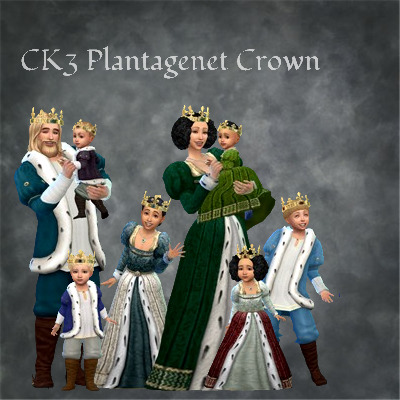
This crown is converted from Crusader Kings III - adapted for sims and made available for all ages - including infants.
The versions for adult, kids and toddlers ar adapted for Hat Slider
Read more and download the sliders here: Hat Slider for adult sims Hat slider for Kids & Toddlers
Infant version is without hat slider - pick hair accordingly.
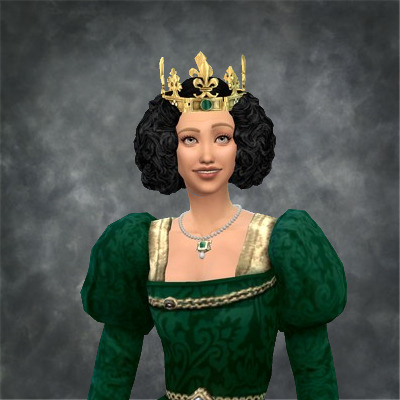
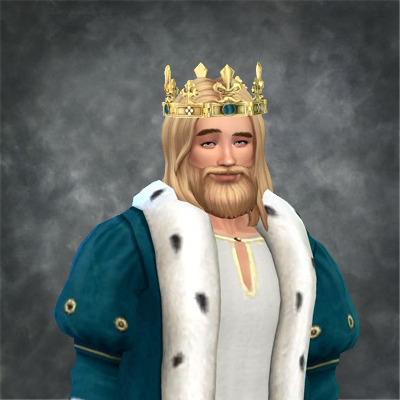
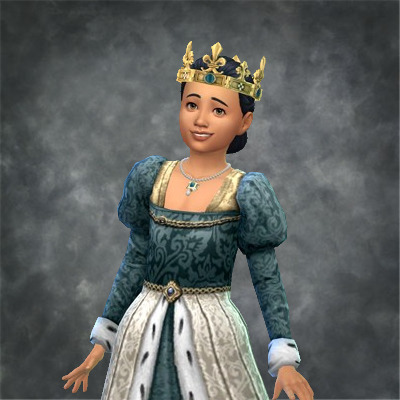
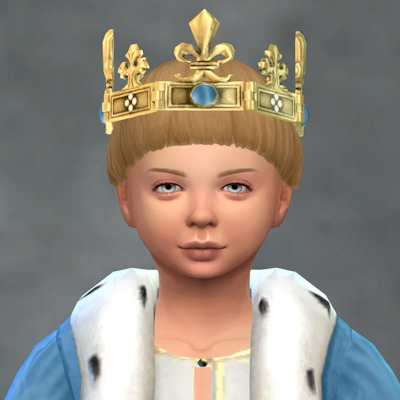
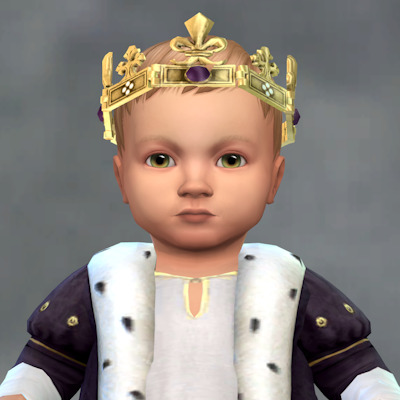
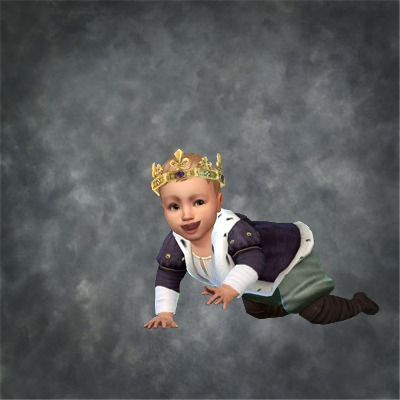
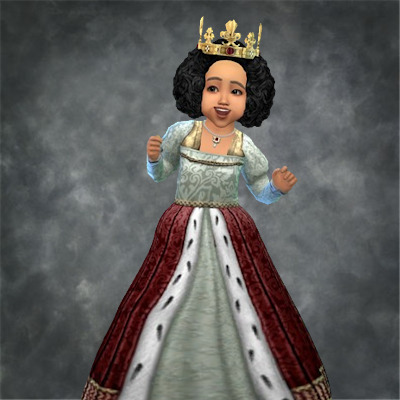
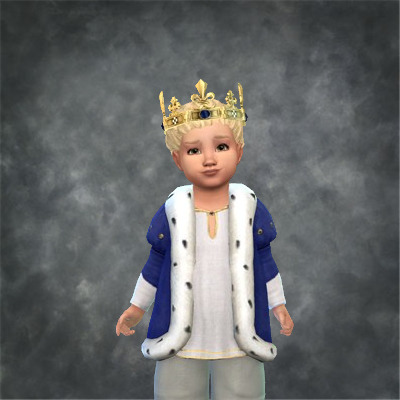
All versions merged in one handy file.
The kids' versions take their textures form the adult version - one merged file.
Unmerge the files if you want to edit or remerge but remember to keep the files together.
Download CK3 Plantagenet Crown (Curseforge)
56 notes
·
View notes
Text
Identifying J.C. Walker's Illustrations
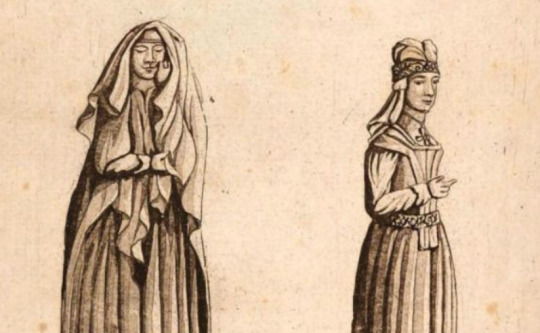
An Historical Essay on the Dress of the Ancient and Modern Irish by Joseph Cooper Walker published in 1788 was the first major work published on Irish dress history. Due to a combination of the limited information known at the time, and his erroneous assumption that Irish dress didn't change for the entirety of the Middle ages, Walker got a lot of things wrong, so his writing isn't cited much anymore. Some of his illustrations, however, are still used.
Because Walker lived before the invention of photography, he used drawings of historical Irish art created by colleagues and family to illustrate his book. I decided to track down the original works of art to see how Walker's drawings compared. I am resorting these into roughly chronological order, because Walker's lack of regard for chronology makes my head hurt.
The High Crosses, 9-10th centuries:
Ireland's high crosses have unfortunately lost a lot of their detail due to erosion, making these hard to identify. Sadly, the breeches with a fitted knee-band and the skirt gathered to a waistband look more Late Medieval or Early Modern than they do Early Medieval, so I don't think these are reliable depictions of the lost detail.
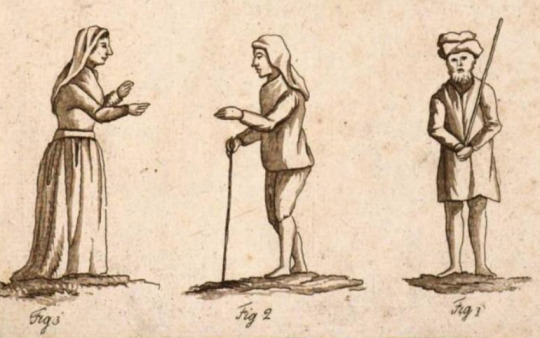
Plate 1: Figure 1 (right) is supposed to be from the Clonmacnoise Cross of Scripture. At a guess, it's based off the guard on the right arresting Jesus:
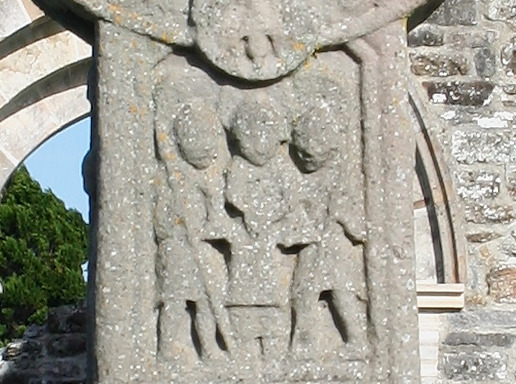
Figures 2 and 3 are based off a high cross fragment at Old Kilcullen, County Kildare. Unfortunately, I don't think the original carving survived. I initially blamed its loss on the United Irishmen, but this drawing from 1889 convinced me that acid rain was the real culprit.
Plate 5 Figure 1 is supposed to be a king from Muiredach's cross. The closest image I could find on the actual cross is Cain killing Able:
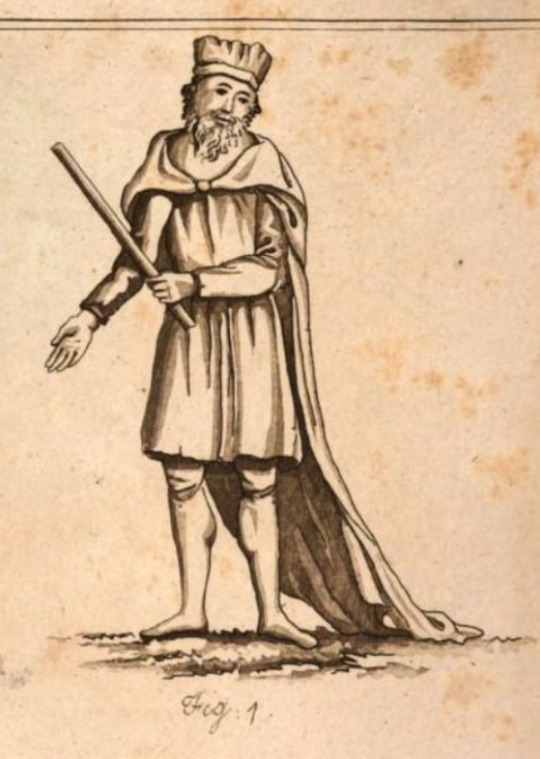
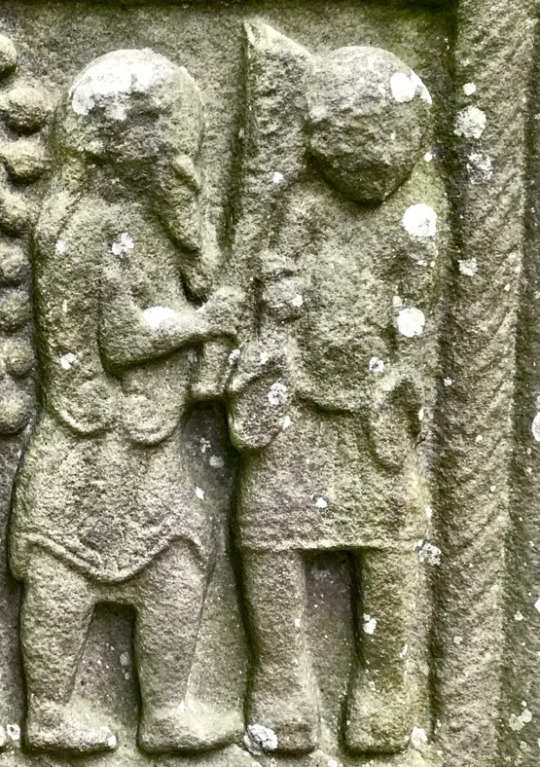
Ironically, Cain and Able have more embellishment on their clothes than the "king" based off of them.
12th century:
Plate 1 Figure 5 is from the capital of an arch at St. Saviour's Priory in Glendalough, County Wicklow. The drawing gives the impression that the sides of the head were shaved and the hair was deliberately curled at the end. In the actual carving, the hair is slicked back at the sides and interlaced with adjacent design elements. These are stylistic elements of Irish Romanesque art and not intended to be a realistic depiction of an Irish hairstyle.
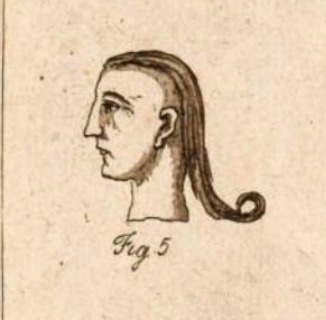

13th century:
Plate 4 is the late 13th century effigy of Felim O'Connor, Dominican Priory of St. Mary, Roscommon with a frontal of gallowglasses added in the 15th c.
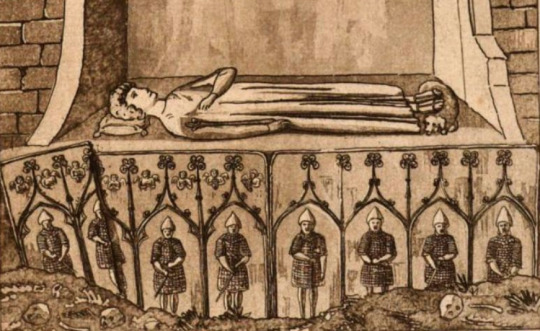
This drawing is pretty accurate, although the gallowglasses are lacking some details like their quilted cloth gambesons.

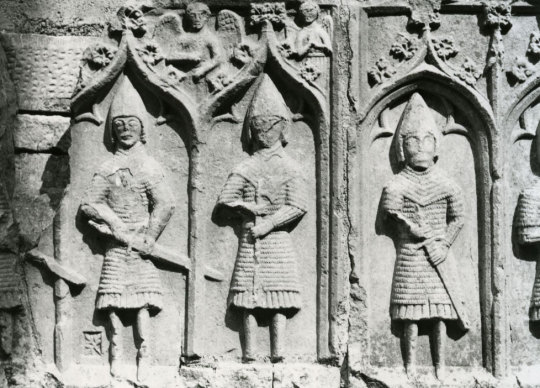
photos by Edwin Rae
I cannot find a good photo of Felim O'Connor's effigy, but Conor O'Brien's contemporary effigy at Corcomroe Abbey, County Clare wears the same style of clothing.
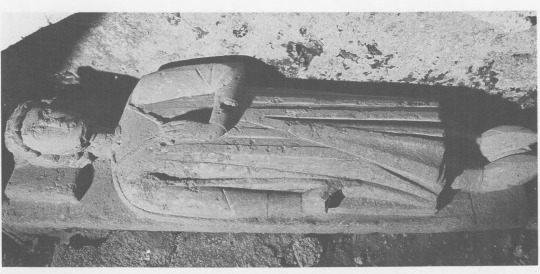
13-14th century?
Plate 6 is based on a sculpture from Athassel Priory in County Tipperary. I can't find a solid date for this one. Athassel Priory was built c1200 and then burnt and rebuilt twice before it was dissolved in 1541. The clothing style of the carving makes me think it's from the earlier part of this time frame.
The biggest thing the drawing gets wrong is the gender. This is a man, not a woman. The "necklace pendent" on his chest might have actually been a brooch holding his cloak, but the sculpture is now too damaged to tell. The drape of fabric at his side, which Walker calls a train, is actually the edge of his cloak. The drawing also leaves out the way his become more fitted below the elbow.
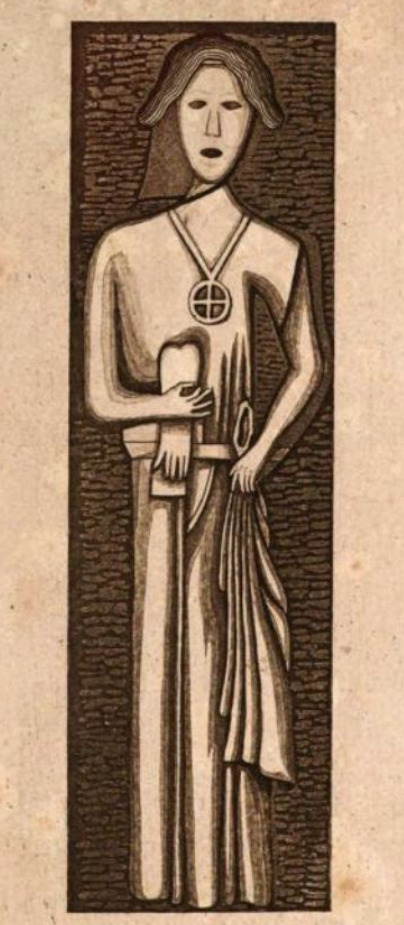
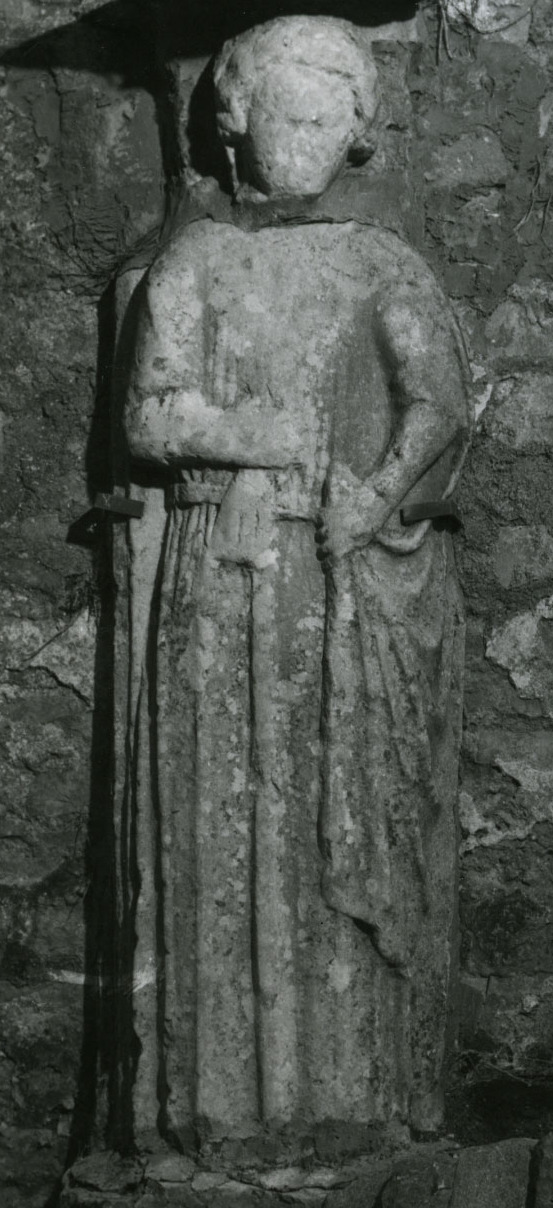
15th century:
Plate 3 Figures 1-3 are based off a painting at Knockmoy Abbey.
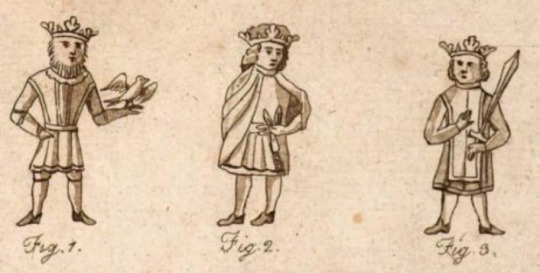
I'm pretty sure those are houppelandes on the left and center figures. This continental fashion influence shows up elsewhere in 15th c. Ireland (Dunlevy 1989). The drawing omits the massive houppelande sleeves and shortens their hems.
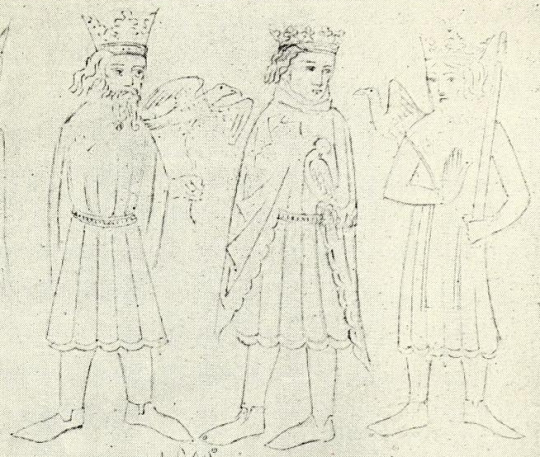
The painting is now badly weather and difficult to see. This is a more accurate drawing published in 1904. Recent photograph here
Plate 5 figure 2 and plate 1 figure 6 come from a 15th c. grave at the Dominican Friary, in Strade, County Mayo.
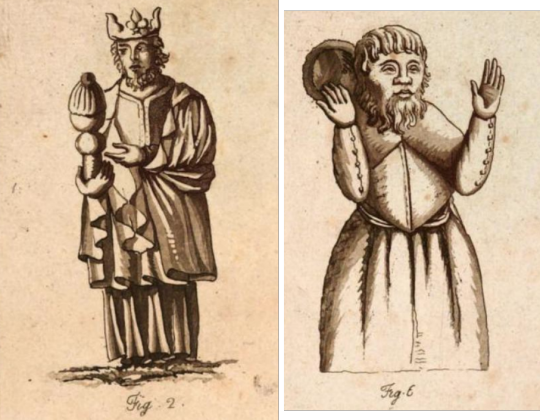
Figure 2 is a decent representation, although it adds a center front slit to the leine which I don't think is actually there. Figure 6 gets the silhouette of the cotehardie a bit wrong and omits the hanging belt accessories, but its greatest crime is that it makes the top of the hood look like a separate object. Walker actually misidenifies it as a Scotch bonnet.
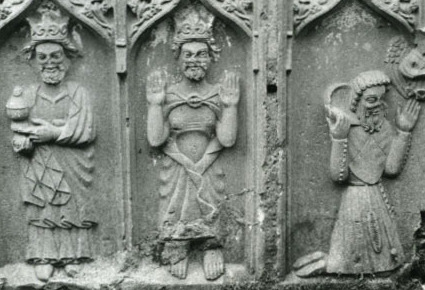
photo again by Edwin Rae
Plate 7 is Anne Plunket's effigy at St. Mary's Church, Howth, County Dublin. This drawing is decent, though the sleeves are a bit too slim. The cross necklace and belt decorations are no longer visible on the effigy.
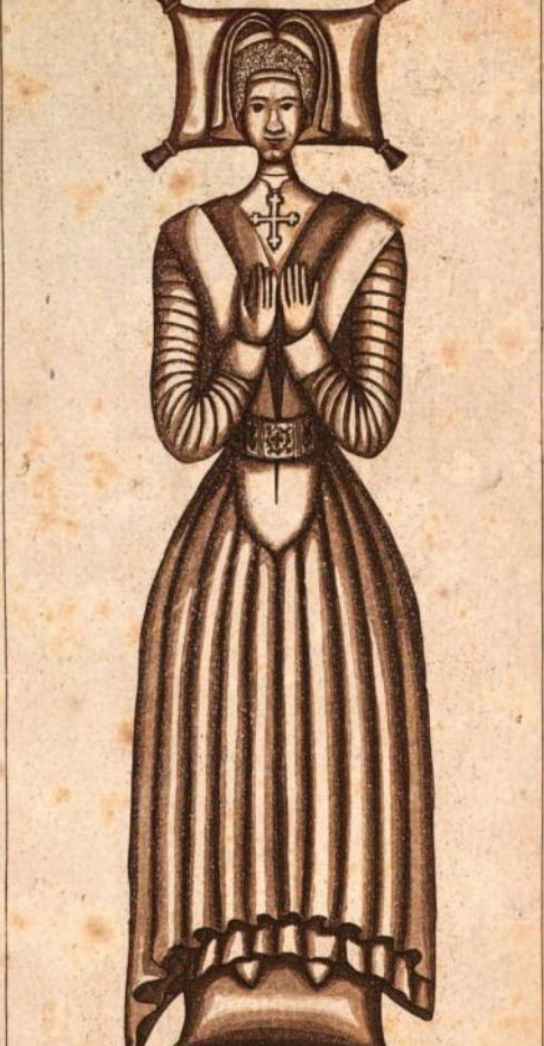
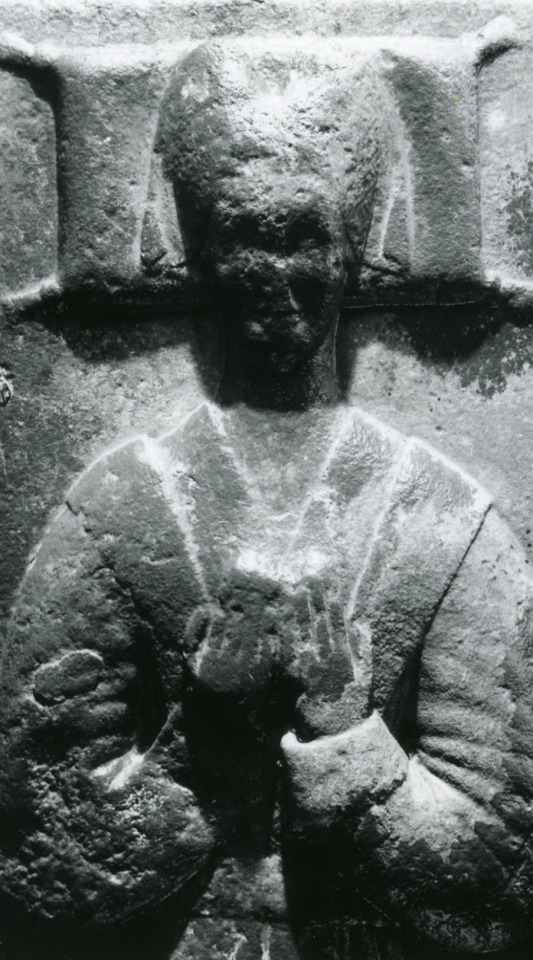
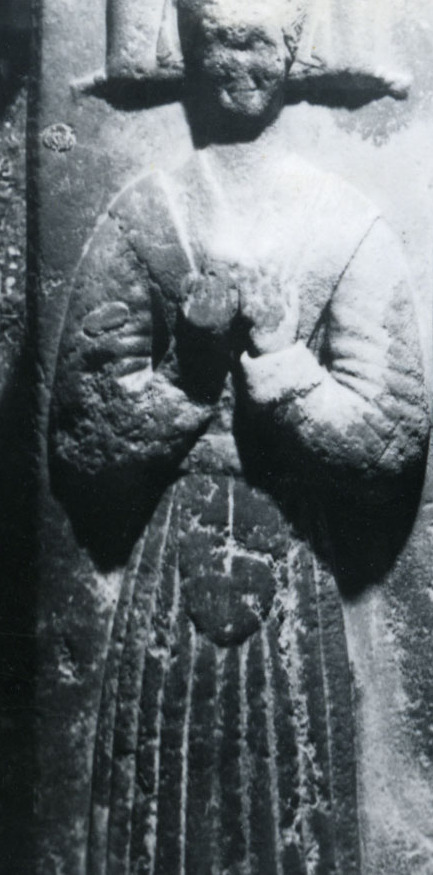
photos by MVP Edwin Rae
Plate 8 figures 1 and 2 are both based on a late 15th c. tomb at the New Abbey in Kilcullen, County Kildare. Figure 1 is based off a carving which is probably depicting St. Brigid, which makes her headwear the wimple of an abbess, not a laywoman's kerchief Walker. The drawing, however, omits her telltale crozier. The drawing makes it look like she has cuffed sleeves, but that is actually just the folds of her brat draped over her arm. It also shows her as wearing 2 layers of skirts when she is actually wearing a single lower garment with a hem circumference so large that it puddles at her feet.
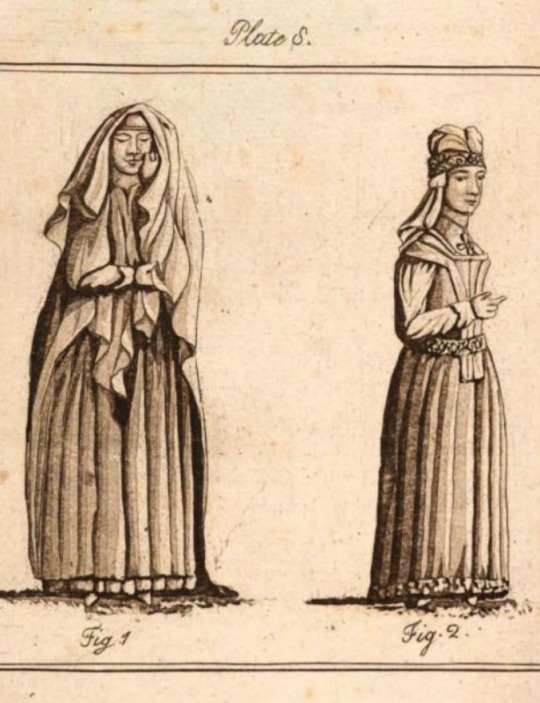

Figure 2 is based of Margaret Janico's effigy. The effigy is now too badly eroded to make out details, but it originally probably looked very similar to Margaret Janico's other effigy in St. Audoen's Church, Dublin. Unlike Anne Plunket's effigy above, the necklace and belt decorations are still faintly visible on the Dublin effigy. Figure 2 distorts the construction of the gown and headwear. This drawing makes the bodice of the gown look heavily stiffened or even boned like 17th c. stays. The houppelande on the effigy does not have stiffening in it.
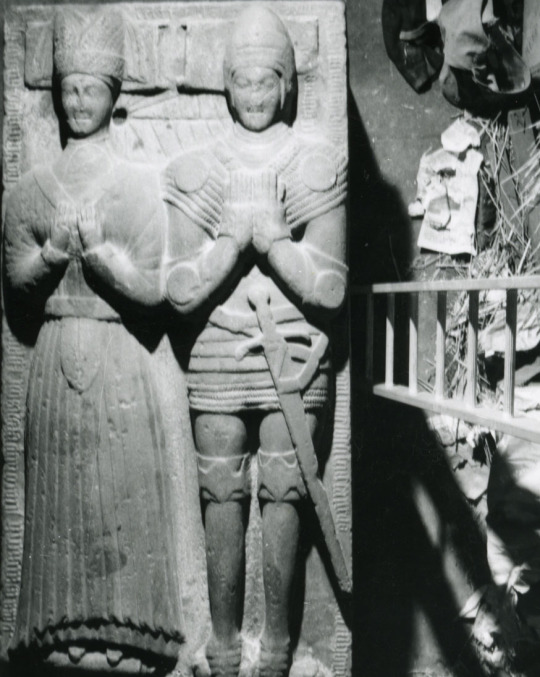
effigy of Margaret Janico and husband at St. Audoen's Church, Dublin (photos, once again, by my man Edwin)
The headpiece in the drawing looks like a linen kerchief wound up to form a turban with a decorated fillet tied over it. The headpiece on the effigy is probably actually a truncated hennin with a veil pinned to it like the one in this mid-15th c Burgundian painting by Petrus Christus.
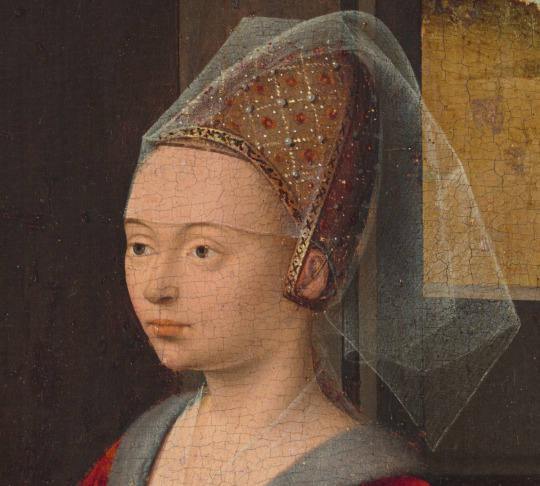
16th century:
Plate 9 is based on Katherine Molloy's early 16th c. effigy at Fertagh Church, in County Kilkenny. According to the artist's notes it was in "nearly perfect" condition at the time. I wish he had put more detail into the drawing.
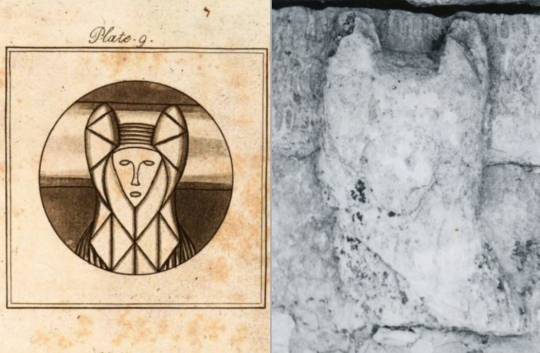
(photo also by Edwin Rae)
17th century:
Plate 10 is based on The Taking of the Earl of Ormond in anno 1600. Walker's artist clearly fabricated some detail here, falsely giving the impression that triús were ankle-length. We know from extant examples from Kilcommon, Dungiven, and Killery that triús actually extended past the ankle, covering part of the wearer's foot (Dunlevy 1989, Henshall et al 1961).
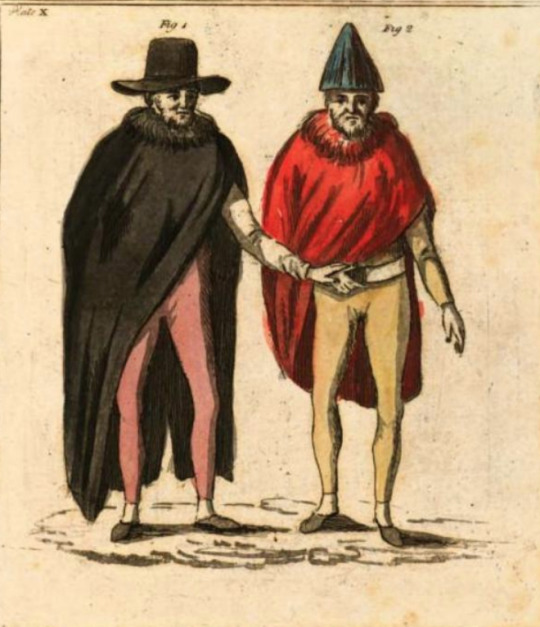
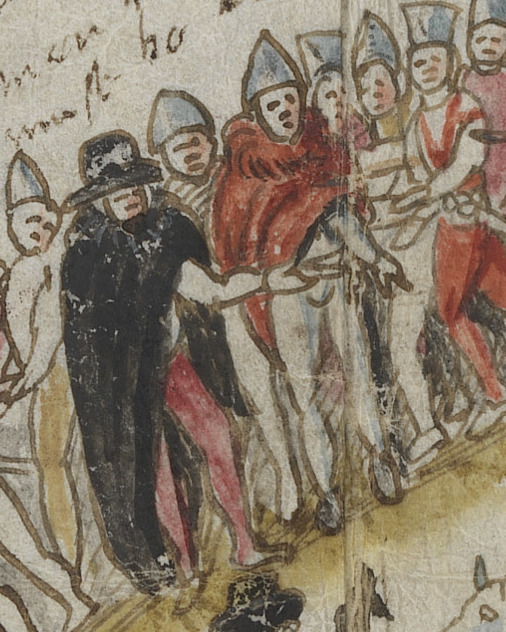
Plate 11 was taken from the tomb of Sir Gerald Aylmer (died 1634) and Juliana Nugent. Sadly, it appears to have been destroyed in the early 19th c, so I have no further pictures of it. The clothing looks to me like typical 1630s English fashion with loose gowns over doublets, falling bands, and linen cuffs.
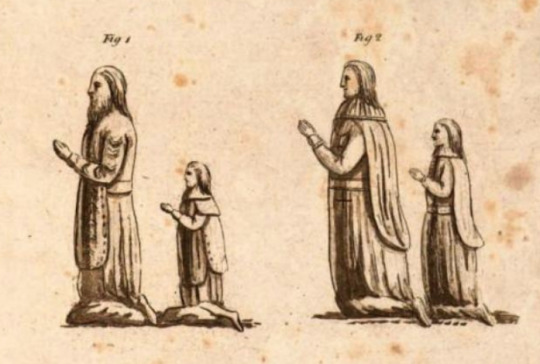
? Century
Plate 1 figure 4 is apparently from Old Kilcullen, County Kildare. I am not sure what this is based on. I haven't seen any Santa hats at Old Kilcullen. Or anywhere else in Medieval Ireland.
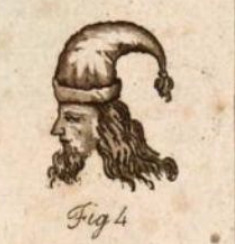
Bibliography:
Dunlevy, Mairead (1989). Dress in Ireland. B. T. Batsford LTD, London.
Henshall, Audrey, Seaby, Wilfred A., Lucas, A. T., Smith, A. G., and Connor, A. (1961). The Dungiven Costume. Ulster Journal of Archaeology, 24/25, 119-142. https://www.jstor.org/stable/20627382
Edwin Rae's invaluable collection of photographs of Late Medieval Irish art accessed via TARA.
#15th century#irish dress#dress history#irish history#art#early medieval#16th century#historical women's fashion#historical men's fashion#historical fashion#hiberno norman#gaelic ireland#headwear
13 notes
·
View notes
Text
My adhd (fuck it I’m self diagnosing because at this point it’s so there that it’s not even a question anymore) has really been hitting lately
Like I start to do One Thing that I Actually Have To Do and suddenly I’m in a rabbit hole of reddit that’s in a rabbit hole of Wikipedia that’s in a rabbit hole of google results (rabbit holeception) and it’s been 5 hours and I can’t remember what the thing I Actually Have To Do is
Anyway long story short I had an adhd and now it’s 10pm and all I’ve eaten for dinner is an unholy amount of kitkat santas
#adhd#brains are stupid#i have read about pagan deities and medieval headwear and liqueurs and mochi and r/shittyfoodporn#somehow i always end up on religious wikipedia or murder wikipedia
0 notes
Text

Portrait of the Codfather
My contribution for @empiropediazine !! It's been done since june and i'm very excited i can finally post it :] Make sure to check the zine if you haven't already, even more if you're a fan of worldbuilding. I'm not great at worldbuilding that's why i applied just for the portrait lol
I'll leave some design notes under the cut for anyone interested <3 I'd love to hear people's thoughts on the zine and the emperors portaits (i'm biased)
- Jimmy's design is very far from his original skin for Empires s1 because let's be honest, it was just a recolor of his superhero skin, we gotta make it more interesting. I have a full design ref for him but breaking it down: green and brown hues (very swampy), orange-red for a pop of color and contrast, clothes made out lots of fabric (old and shredded to emulate vines and water plants for the swampy vibe) and the Codfather's head (mask in this case) which is heavily inspired by the headwear of Link's zora armor from Twilight Princess + the red fabric to cover the back of his head.
- Holding a dead salmon for obvious reasons.
- For the designs on the picture frame i took some inspo from european medieval illustrations, that's why there's two fish with human faces, i found a picture just like that and i thought it was funny. The rest is just cod, blue orchids and orchid leaves.
#breoasis art#empires jimmy#solidaritygaming#empires s1#empires smp fanart#the codfather#empires smp
2K notes
·
View notes
Text
if anyone has information for me on european medieval clothing let me know, because right now I tend to come across the 'everyone in europe was dressing mostly the same' thing a lot and I simultaneously believe that and struggle with it and would like some sources to learn more about this
#fashion history#medieval clothing#medieval fashion#also just in general I would like to learn more about this#since rn I mostly know about kirtles in one colour and st brigitte caps? iirc?#like I know a liiiittle bit about headwear varieties but not much about actual clothing#and wouldn't be able to date any of it beyond 'vaguely medieval' lmao
1 note
·
View note
Text
Sewing a turn of the 15th century French kirtle in doll scale
Another day, another historical doll outfit! This time it's Late Medieval. This was a popular style from about 1380-1420 France and Alpine area, but I specifically based this dress on French illuminations from the early 15th century, which mostly effects the details, like headwear. As always I hand stitched everything and stuck to historical construction methods as much as I could.
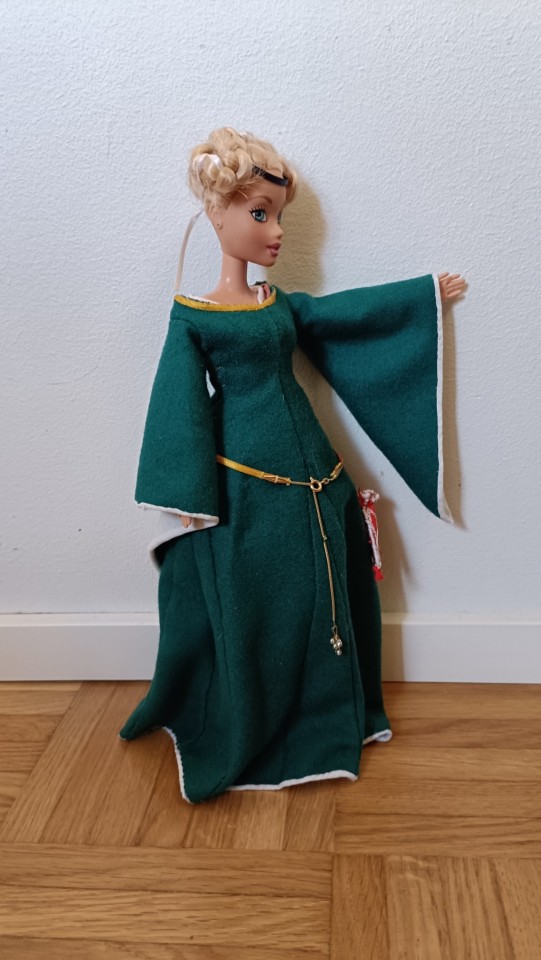
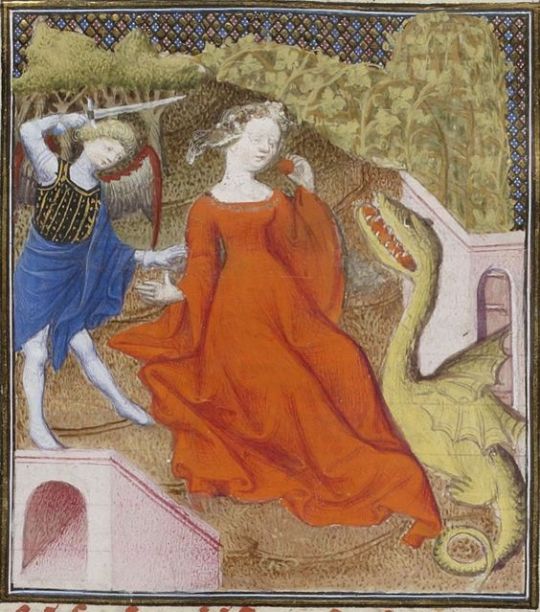
Chemise
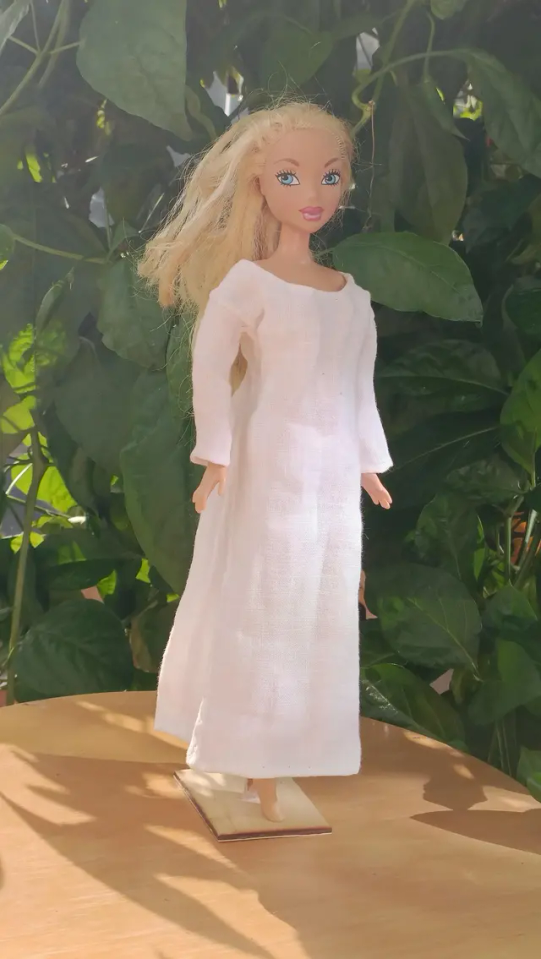
I made a very simple chemise. The construction is based on what we know from extant finds, made out of simple rectangles and triangles, like earlier unlaced kirtles. Based on illustrations, chemise was fairly slim but unfitted enough it didn't need closures. I made it from linen, because it's not very gathered and won't bulk up too much, so I don't need to use my very fine cotton voile.
Cote
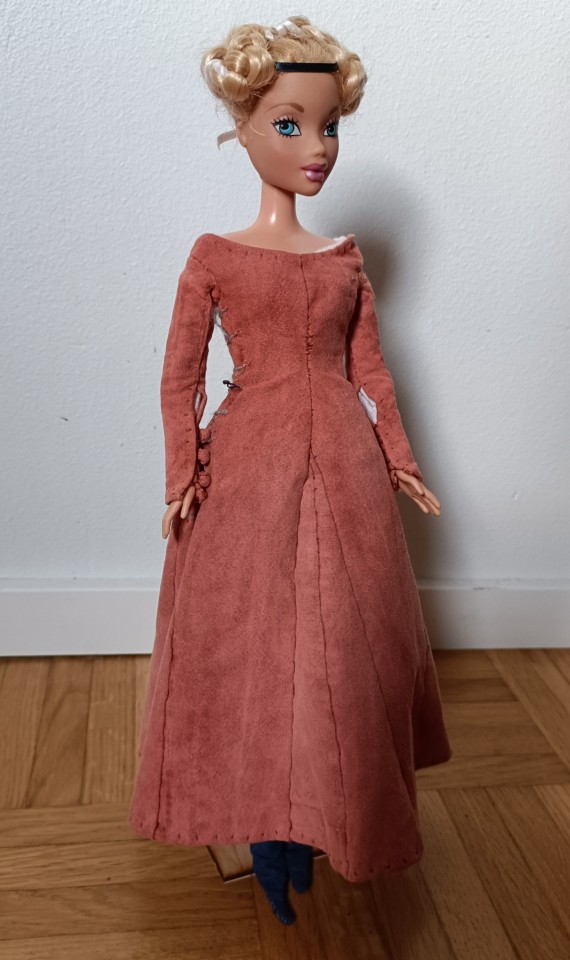
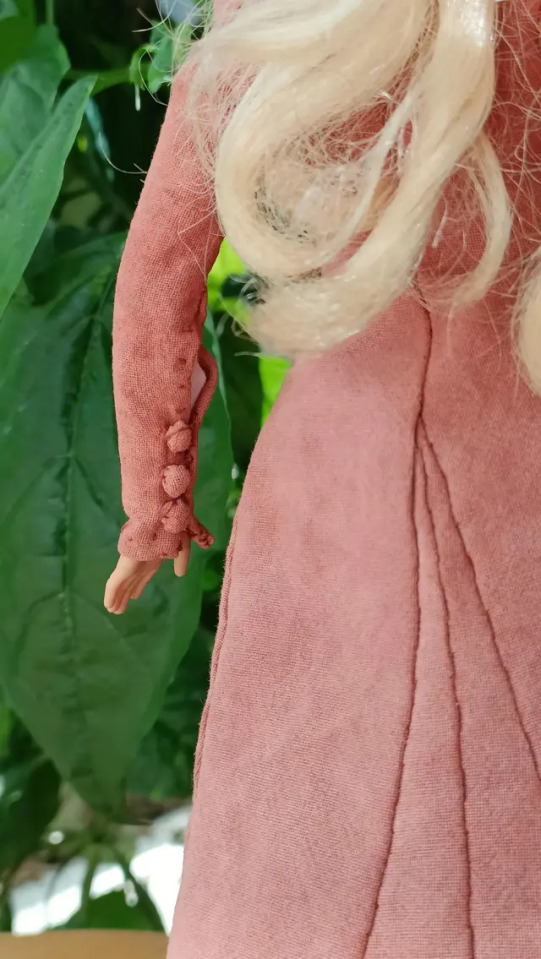
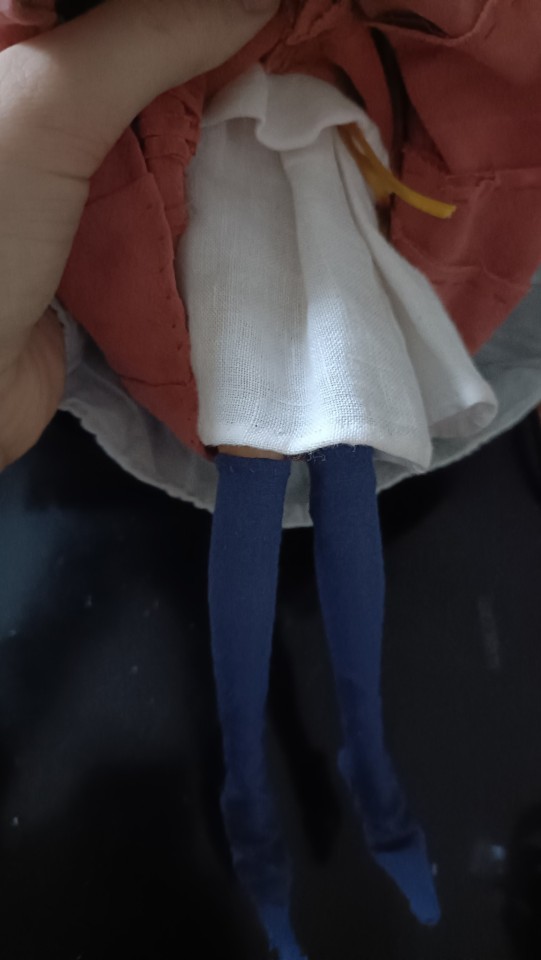
Cote is just the French word for kirtle, so appropriate here. This is the supportive layer cote, which was sort of an undergarment, but was considered fully dressed, if informal on it's own. The sleeves on this underlayer were always long and either fully fitted or gathered at the wrist. Some fitted sleeve styles had a flare at the wrist which covered the hand. The very fitted look was achieved with buttons. The silhouette was smooth and fitted, the waistline was slightly above the natural waist, though that was not as pronounced in France as in Northern Italy. Abdomen was emphasized, round lower stomach was the body ideal. The cut of the dress left plenty of room there. To fill that room I folded the chemise under the abdomen as a sort of padding. This was common to do with any kind of skirts, primarily to raise the hem when working, but why not for this purpose also? The necklines were fairly low and very wide.
I used cotton because I didn't have suitable thin enough wool that wouldn't have created too much bulk on this scale, but the cote should have been made from. The cotton is tightly woven and sells the look of a woven wool in this scale well enough for me. I didn't finish seems or line it to avoid bulk. I did give the lacing a cording to reinforce it and avoid wrinkling. The cotton was originally white, but I dyed it with iron oxide, basically rust, which at least is very much historical.
Hose

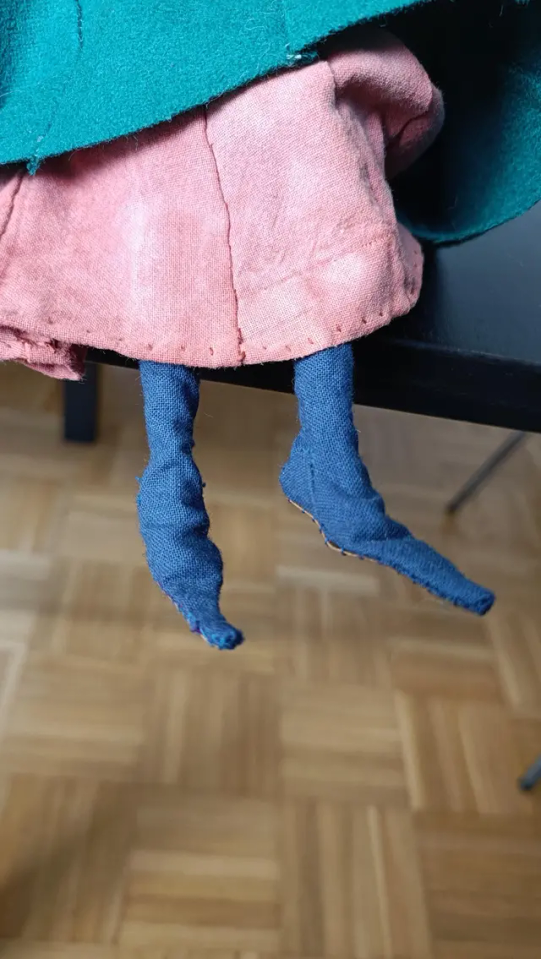
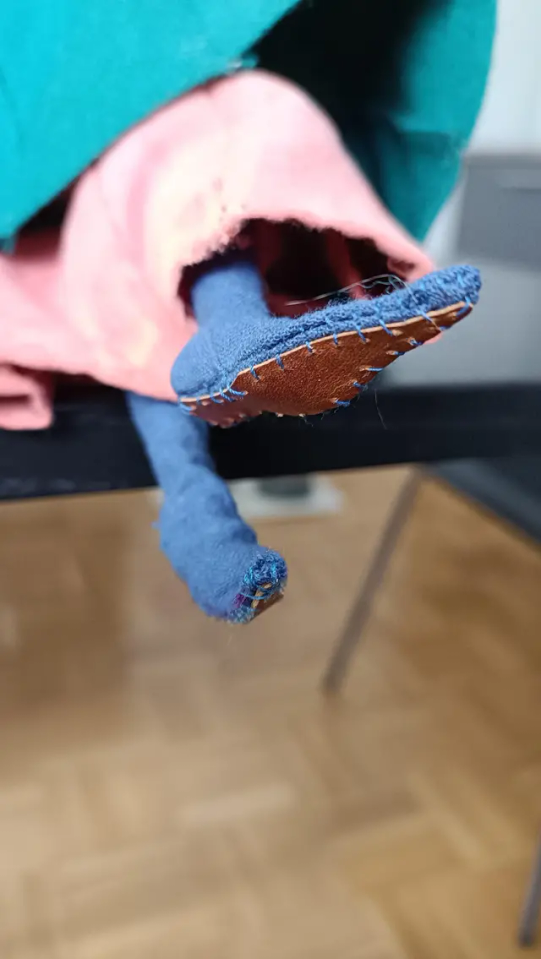
I made the hose from cotton as well for the same reasons as I did the cote. Long pointed style became fashionable around this time, as well as sewing leather soles in the bottoms of the hose instead of using shoes. Though often pattens (wooden flipflops basically) could be used when walking outside to protect the leather soles.
Cornettes or horned hair
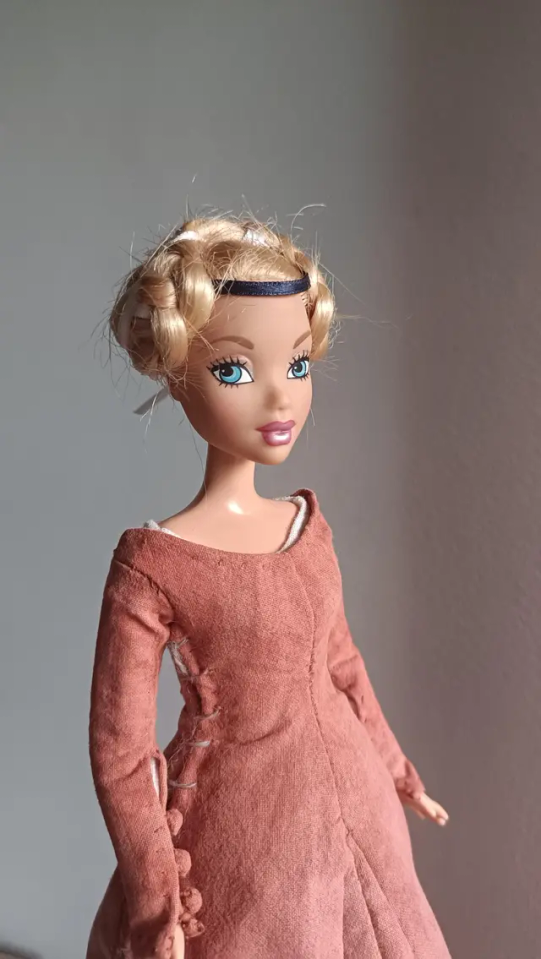
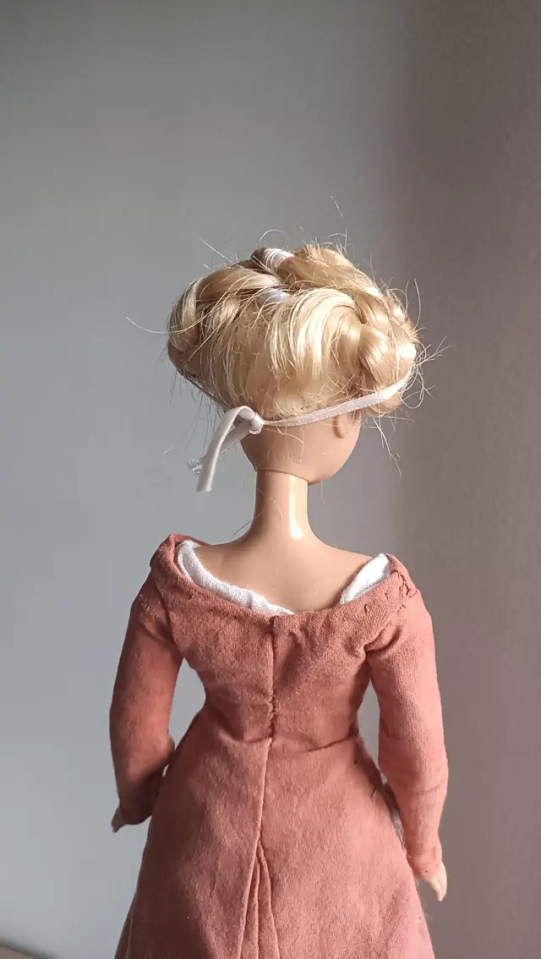
I tied the hair with a tape on cornettes, where the volume of hair was tied on the temples to create a bit of horned appearance, especially when combined with the horned headwear. The sort of fillet which became more of a forehead loop seemed to have been tied into the hair, which I did.
Cotehardie
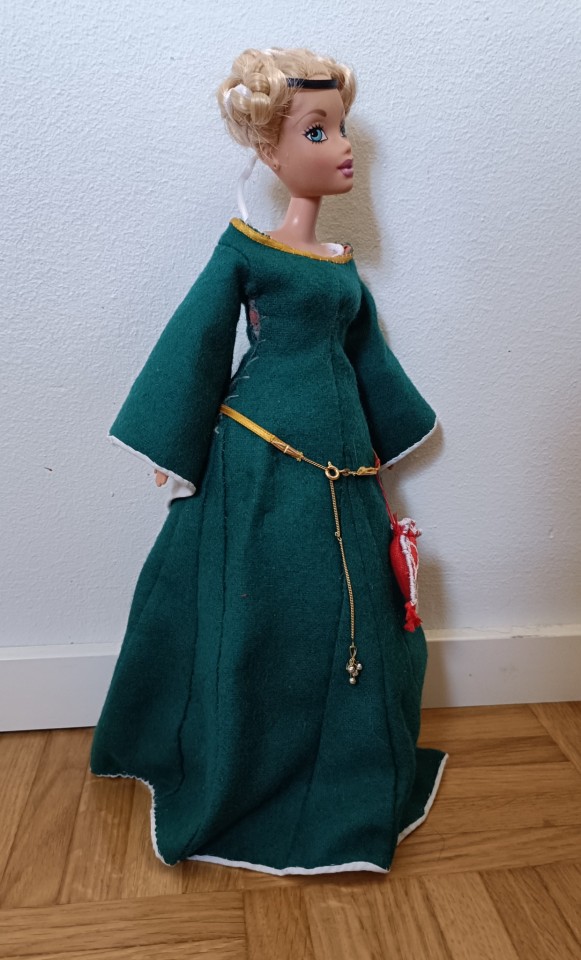





Cotehardie meant literally "bold cote", and in France that was what the formal outer cote was called. It was basically the same as cote, but made from more expensive materials and often had large hanging sleeves. I went with widening triangular sleeves, since they were perhaps the most popular sleeves at the time. I used fine fulled wool (verka) I had enough scraps left from. White fur was popular lining material, but obviously I can't use fur in this scale, I wish I had some light white velvet, it would have been pretty good, but I didn't. I lined the skirt and the sleeves with white cotton to imitate the look without adding too much body or extra bulk. I decorated the neckline with a simple golden trim. I thought about adding a bit of golden embroidery around it too, like seemed to have been popular, but my local crafts store had run out of golden thread so I decided to go with this only.
Accessories
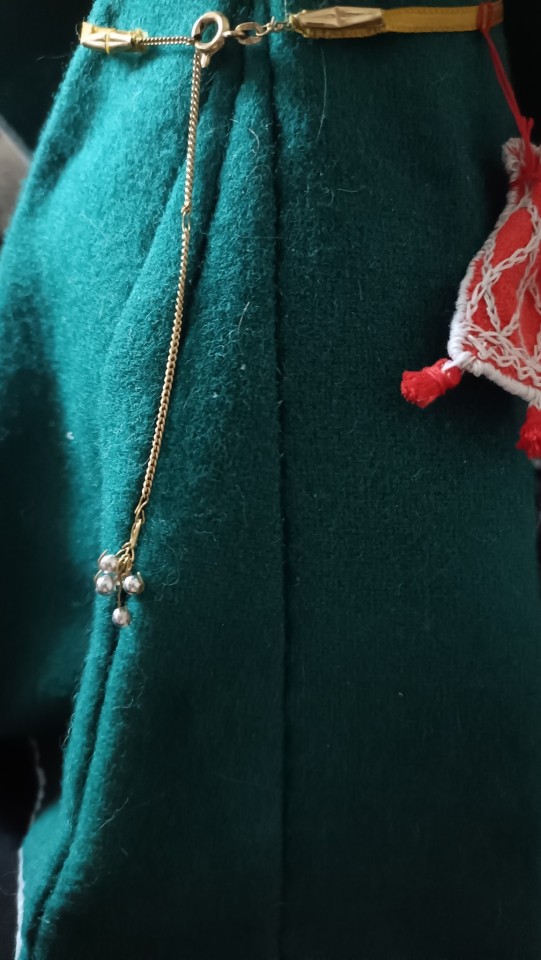



Unlike the belt used with houppelande, which was below bust, the belt used with the kirtle or cotehardie, was very low, under the abdomen to emphasize it. I went for a silk belt look, which I'm imagining is embroidered/woven with golden thread, since embroidery that small would have been too painful. I had an old broken necklace, which I could use for the metallic parts.
With the pouch I went for the tasseled drawstring look, with simple embroidery manageable in this scale. I used linen for it.
Headwear
I made her a chaperon, which likely was where the escoffion got it's beginning, escoffion being the round tube-like headwear worn on top of the head seen in several primary source images above. Early form of escoffion was becoming very popular at the time, though chaperon's were still seen on women too. Chaperon, as seen below both on the left-most woman and the man in the middle was actually just the hood rolled into a circle.
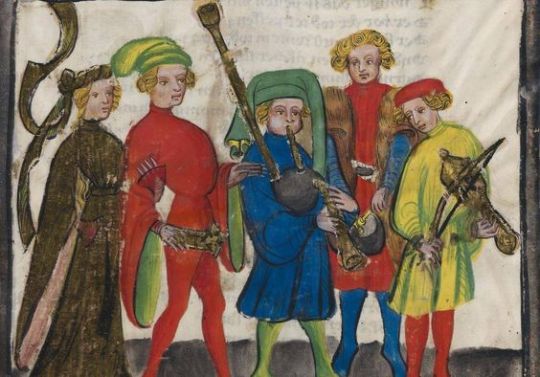
Because the horned look was popular, the escoffion and chaperon were often worn over the wired horned veil, so I first made that. I made it from cotton to make it as light as possible. It was just a square I hemmed. I just used some wire to poke out the horns from her hair and pinned the veil close from the back and onto her hair from the top.
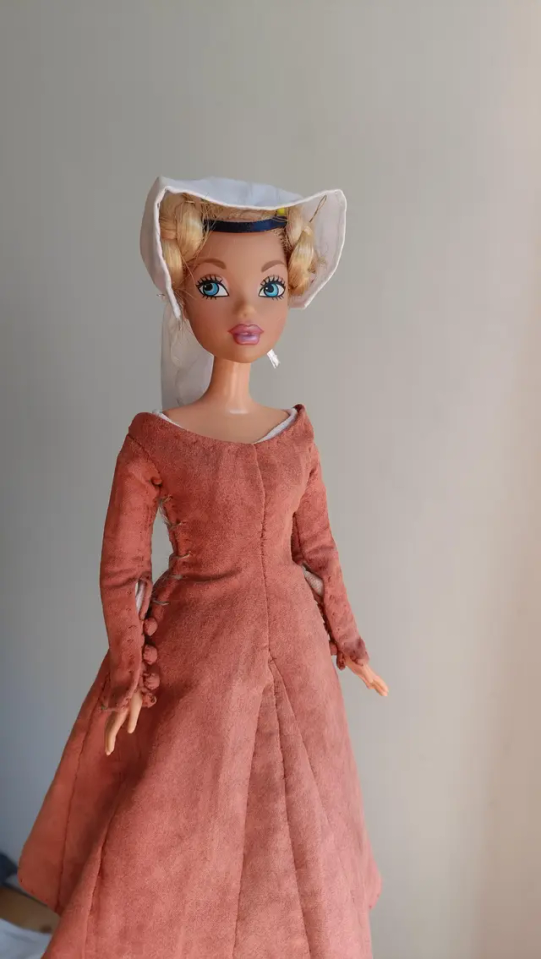

Then I made the open hood. It was just the regular hood which had become very popular during the last century and which had ever longer narrow tip, but it was pinned and worn open, probably because of the hair style and to again create the horned look. I made if from the same cotton I made the hose, even though it too should be from wool. But it was already too bulky as it was.
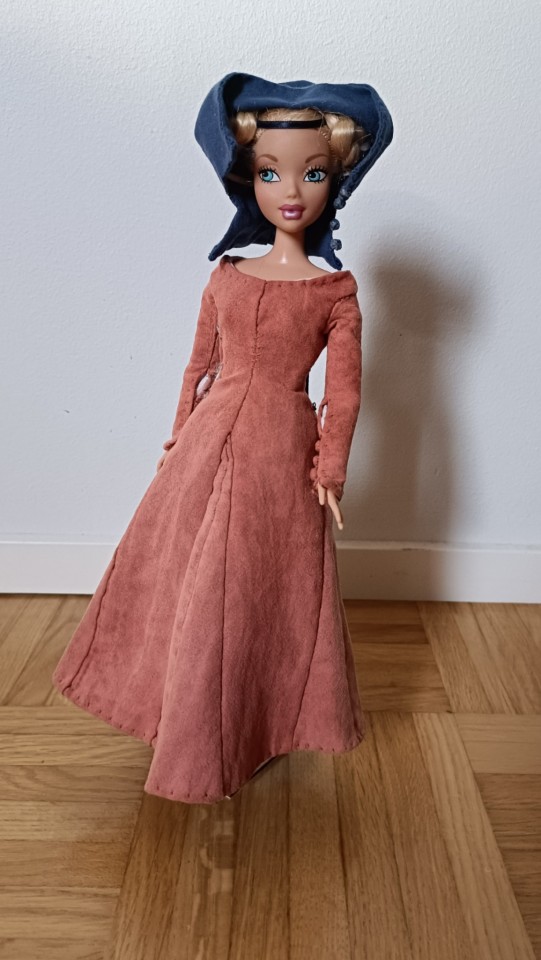
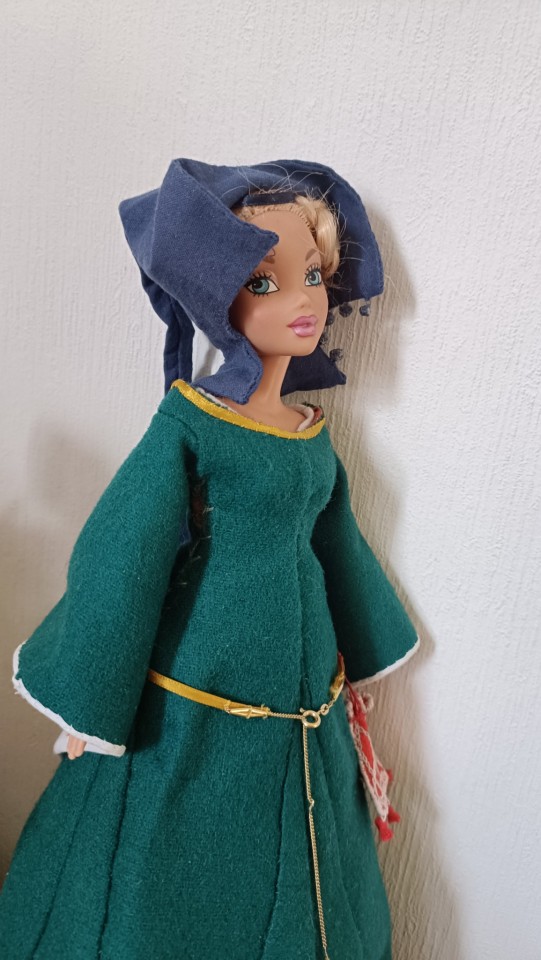
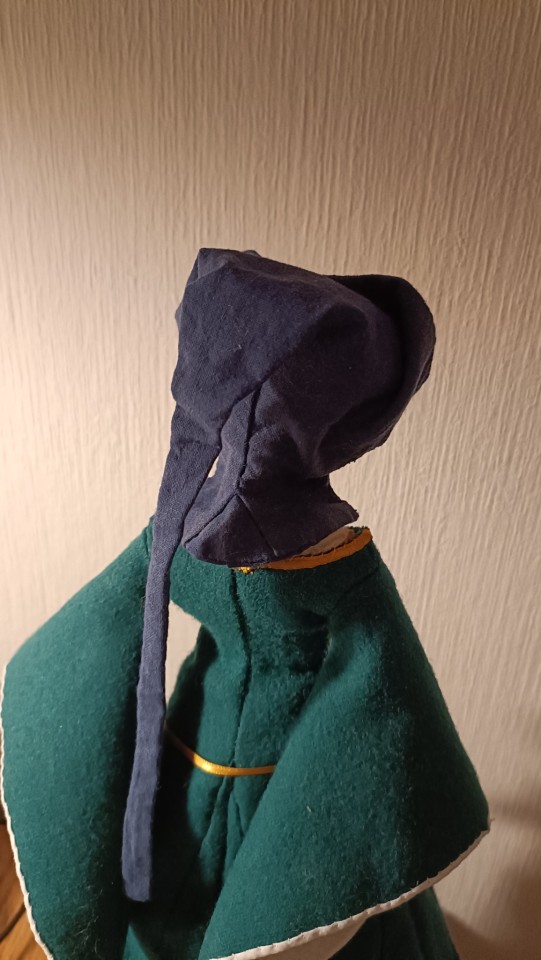
And finally I could make the chaperon. Here's first chaperon without wire or veil under it and then with those. The effect isn't as pronounced as I would have hoped because the hood is too bulky, but there is an effect which is nice.

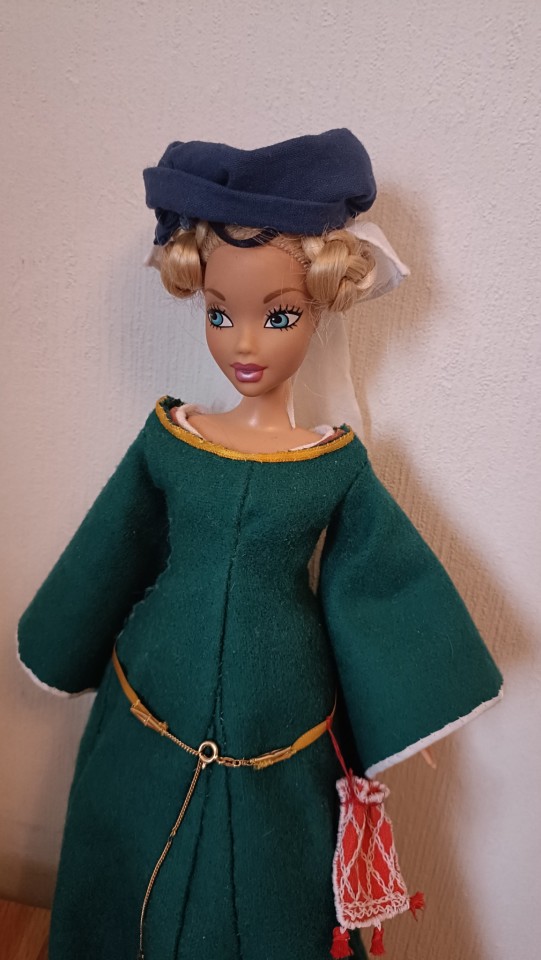
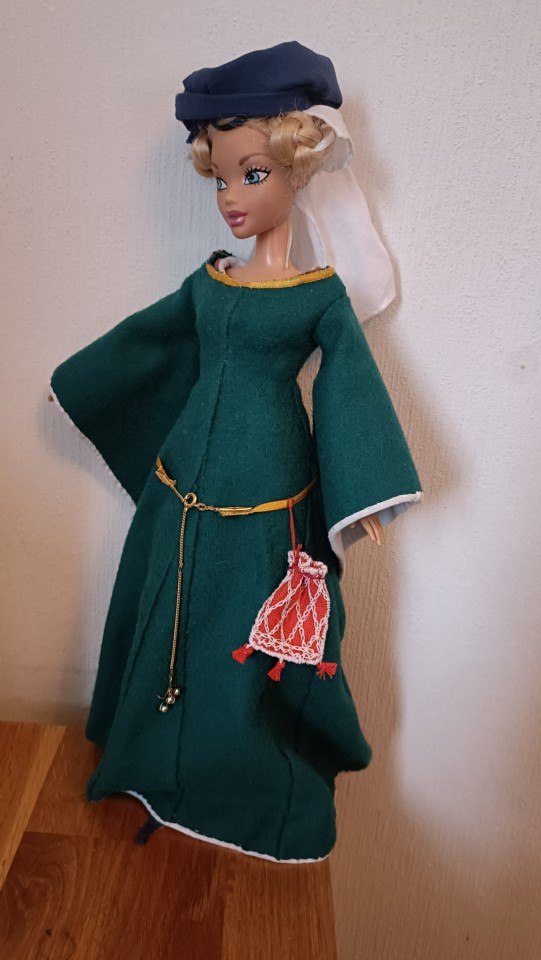
#fashion history#historical fashion#sewing#custom doll#ooak doll#fashion doll#historical sewing#medieval fashion#late medieval fashion#history#historical costuming#my art#doll customization#dollblr#dolls#doll clothes
432 notes
·
View notes
Text
Can I just say, the fact that the high lords don’t all wear generic crowns in their colors, but it actually ties to their courts makes me happy?and they probably all have quite a few different themed ones?
Tamlin with his burnished gold laurel leaf crown at the wedding that was a courtly version of the calanmai crown he probably dawns each year? And his tithe crown is so suited to more strict moments with its representation of wealth and stability?
Tarquin with his silver cresting waves and blue gemstones for a casual night out on the town? As asymmetrically stunning as the very waters he connects his court to, the blues of the stones glinting with white and green and the depths of the very ocean hidden by the brash, crashing beauty created by the surface?
Helions spiked gold crown as vicious and pointed yet beautiful and picturesque as the suns rays? As warm in color as his skin yet simple and statement making in it power just like helion himself- not needing much adornment to radiate the strength, beauty and deadly power and wicked intelligence he holds?
Rhys has a raven feather crown which makes me wonder if previous highlords of night weren’t just serpentile like the creatures of the hewn city but dark winged and raven featured in some way? (And Feyres crown - complimentary to Rhys isn’t just a newly made item, it existed in tandem with his for previous ladies of night I’m assuming so it ties to the court that way as well?)
Autumn court with its mixture of Medieval English and conqueror era Spanish style in my head? With traditional red and green stones highlighted the most and silver and gold alike, crosses and points to their headwear? Very formal and structured, not just to denote their position, but to reinforce tradition, wealth, class structures, very inline with what I’d assume of the autumn courts viciousness mentioned in the books? Beautiful but vicious.
Winter court with near white shining metals, carved glass and crystal bases for ice diamonds; blue, gray, & frosty fogged stones? Dark blues and wicked gnarled features representing barren branches and shards of ice????
Dawn court with its sweeping elegance and love of beautiful embellishments and pension for color? The people are noted to be largely from Xian as noted by SJM and I always imagine dawn court to be a beautiful mix of Indian and Chinese culture, and the jewelry reflects it, beautifully Intrically carved warm toned metals that depict stories or symbolism entertwined with the culture? Stoned used abundantly yet they’re never garish? They only enhance and bring out the beauty of the crowns and reflect the cultures within the court itself?
(Like I’d love to dive deeper into it and maybe make or paint the crowns one day but that’s a different story)
That’s it that’s the post grammar be darned.
#this was written from memory so if any of the crowns are wrong please comment and I’ll edit!!! thank you!!#acotar#sjm universe#sjmaas#tamlin#pro tamlin#tamlin acotar#high lord#night court#rhysand#feyre archeron#day court#dawn court#winter court#autumn court#summer court#spring court#prythian#tarquin#beron vanserra#kallias#helion acotar#helion spell cleaver#thesan acotar
169 notes
·
View notes
Note
Hello, first of all I love your redesigns of the Winx Club. Second I was wondering what the medieval gowns would look like in your redesigns? Also could you please give us more info and examples of the traditional fashions of each planet please, personally I really want to know more about the Deliosian clothing!?
Gah you’re so sweet! Thank you! Amd I’m unsure which medieval gowns you’re talking about but feel free to send a picture so I can see what I think about them
And I may have gotten a little overzealous with this stuff so I’m just going to upload in chunks for each planet
We got Court Wear for Domino here as well as an example of more casual everyday wear most of the public wore







I’ve decided I’m going to be doing these as separate posts for each of them because I ended up doing waaaay more than I meant to for some of them
What’s on the pages in order for notes plus some additional info below!
Picture of Marion
Dominion Court Wear before The Fall:
Started appearing around the time Marion's grandfather ruled, mainly in the corset style and waist length. Drapery and larger poofs added next. Marion pushed for more modern trends and started making her own when she became more active in court, Earth age ~13.
Overall:
- More points and angles
- More gems
- Lower bust/neckline
- Sleeker silhouette
- Pattern work more shape based, cross stitching popular
- Larger poofs on sleeves with them ending mid arm or acting as the whole sleeve
- More upturned shoulder accents
- Lower waistline
- No arm bands to separate poofy part of sleeve from the rest of it
- More connected drapery
- Oval gems present
- Larger hairstyle and more half up half down looks
- Skirt length floor length and uniform
- Elevated heels for footwear
- Thread work less visible if not solely decorative
- Corsets more popular and more decorated
- Hip accents to exaggerate shape
- Wrap around adornment connected to corset, typically with a 3 circle motif
Picture of Hagen
More Pre Fall Wear
Style more associated with traditionally masculine appearances, but like all looks can be worn by anyone of any gender or lack of gender. Acted much more as a fusion of modern and traditional elements.
Main Staples:
- 2 piece set
- Slimmer shape
- Top ending around mid thigh
- Skin trousers visible
- Level shoulder adornments on what would be considered more traditionally masculine fits
Traditional Dominion Features:
- slimmer sleeves with decorated cuffs
- Embroidery lining sleeves
- Braids
- Longer facial hair and hair overall
- Jewel decorations holding caps
- Cape going to knees
Picture of Bloom
Traditional Dominion Fashion
For hair: up with a few pieces of hair down. Braid work, cloth pieces with gems worked into hair
For Clothes:
- shoulders pointed out, typically have line pattern embroidered into it
- gems typically in groups of 3
- Empire waistline
- Flared train on lower half with underskirts typically visible, high-low cut present, usually lined with pattern at the bottom
- Images used in pattern work
- Swirls with pointed lines
- Boots, low heels
- Delicate and intricate metal work on neck wear, typically chokers
- Upturned tip on boots
- Gems are circle or teardrop shape
- Smaller arm poofs
- Arm cuff higher up on upper arm for arm poof
- Sleeves are separate from the arm poof
- Multiple strips of loose cloth
Picture of Oritel
More Traditionally Masculine Elements for Traditional Dominion Fashion not already mentioned previously:
- Boxier shape
- Decorated arm cuffs
- Longer length arm cuffs
- More level headwear
General info on page:
- Shorter hair and beard more common among closer associated people during Marion’s court fashion
Medallion:
- worn commonly by the consort of Domino
- Used as a way to show acting as head of the main ruler of Domino
- Sent with Bloom to Earth during The Fall
- 3 points to represent power in all directions, petals to represent the flowers that grow in magic dense areas, stylized trees to represent the lush forest land Domino has
Picture of Daphne
Fusion:
- combo of traditional and Marion’s court style
- Very common for a lot of the higher class and mobility with less wealth
- Daphne’s preferred style for formal events and appearances, both pre and post-resurrection
Info on the necklace:
- a traditional neck adornment style
- Style from the very beginnings of Empire expansion
- Originally would hold gems of conquered cultures
- These gems started being returned and replaced with Dominion gems right before the fall as part of the effort for reparations on Domino’s part to start making up for its violent past
Picture of Bloom in 2 outfits:
These are some more common outfits for the people outside of the upper and noble classes. They tend to be more reminiscent of traditional Dominion wear since the newer stuff in Marion’s court wasn’t very practical for the usual day to day activities such as running errands, doing manual labor, and artisan crafts.
General rules that were mentioned earlier still apply, just typically with less elaborate pattern work and embroidery. Rarely any jewels in day to day wear. It’s more common for families to have a few gems that they share and fit into different pieces of metal work for more important events and holidays.
Notes on the page:
- corsets ending a little above the waist
- Embroidered patterns on clothes
- Peasant blouse style shirt popular
- Boots all year
Flame Acolytes:
- group that works with The Flame and are in constant worship of The Great Dragon
- Cloth all blue
- Dragon tattoos on both arms, wrapped around arm 3 times, head on palms with mouth open
- Gems are purple
- Stretched earlobes from jewelry, style varies (bonus: Saladin wears this style in honor of Domino’s passing to this day. He found it in the ruins of Domino on one of his visits back that he and others of The Company of Light as well as other scholars took to see of there was any way to salvage the people and the planet itself)
- For the dress, front and back pieces tied together on the sides
- Dress underneath it
- Shoes made of cloth, a style left over from older form of widespread foot coverings
#winx club#winx#asks#ask#world building#lore#worldbuilding#domino#the fall of domino#winx bloom#bloom winx#winx daphne#daphne winx club#daphne winx#bloom winx club#marion winx#oritel winx#hagen winx
42 notes
·
View notes
Text
Fansession rambling time before I go back to sleep!!!
Lusii and Carapacians in my fansession have formed a mutualistic bond on post reckoning Alternia and the two races often aid eachother. My headcannon is that Lusii can project their voices but cannot read minds(save for some species I'd imagine) and most have adapted and learned to speak carapacian!
Lusii on post reckoning Alternia are revered by its Carapacian inhabitants because instead of a desert biome,the land is pretty much the same but overgrown and wild meaning all of the dangerous flora and eventually fauna are deadly to those who don't know their way around. So the lusii guided the Carapacians and in turn both parties gained companionship, protection, and shelter(Example:Surly Milkmaid and Playful Nanny, SM provides shelter and care for PN who provides companionship and milk to sell)

It's not unusual to find carapacians wearing headwear and or armor fashioned after lusii after being on Alternia. Most commonly this is done for good luck but can mean many things(Example: EM in her Derse attire has headwear fashioned after a tiger lusus because she admires their ferocity and cunningness)

But it's also common for headwear and armor to be fashioned after lusii companions past or present! In turn most lusii will adorn themselves in the colors that their carapacian companions wear.(Example:Loyal Steed wearing barding in the Dersite colors that Daring Courier wears)

However not everything is perfect, due to the insane amount of outer god tampering and influence on the session there is the presence of cult activity(these cults are not only on post reckoning Alternia but hold a very real danger for it's unknowing inhabitants.) Lusii will sometimes be coaxed in by cultist who will provide them food and shelter and promises of companionship before sacrificing them to their god of choice. Ectobiology machines in my fansession are almost all infected by fragments of horrorterrors, most of which feed on blood, meat, and negative emotions. So the machine will not work without a blood offering. All of the carapacians generated in this session are sterile so they depend on these machines to keep going when people die, but most people don't know how they really work since the holy machines are protected and hidden by churches away from the public, many of which have fallen into outer god worship.
However some churches don't contain cultist and members will willingly sacrifice themselves in order to create more carapacians. It's a somber event but also a grand celebration is held for the person beforehand. Their favourite music is played, their favourite food cooked, and they are embraced by everyone before leaving. It is seen as honorable and brave that they are willing to give up their live for others to have a chance but the person will not be shamed or judged if they change their mind.
Okay to wrap this up lol many Alternian tech is still present, not all of it works but some are still functional. It's not uncommon to find a radio in someone's home or even TV's and VCR's. These are seen as valuable and groups of carapacian and lusii will venture out together to collect working tech to sell or use. While the setting is medieval its completely normal to spot adventuring parties gathered around tablets for entertainment or Inns and Pubs playing old Troll movies and shows from cd's on refurbished TV sets
17 notes
·
View notes
Text
Katharine Updo for all ages

Note: There was a problem with the texture links for the kids versions - I updated the files. Please redownload, same link!
As I was working with more medieval headpieces, I felt the need for a hair to use under hats and headwear.
This is a slim updo with a knot, made to be as little intrusive under hats as possible.
Edited EA mesh. All EA swatches.
Available for all ages - infants to elders.

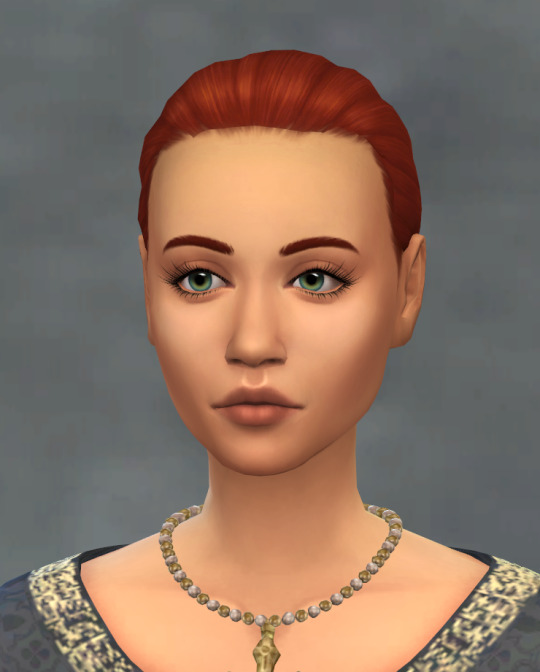
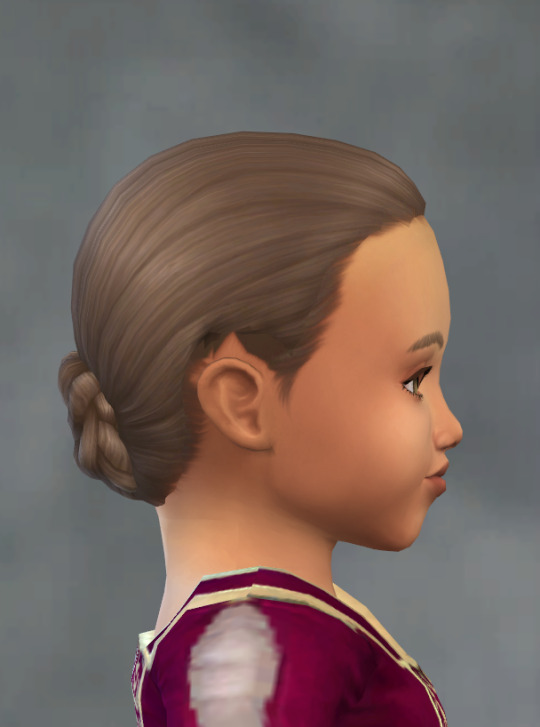

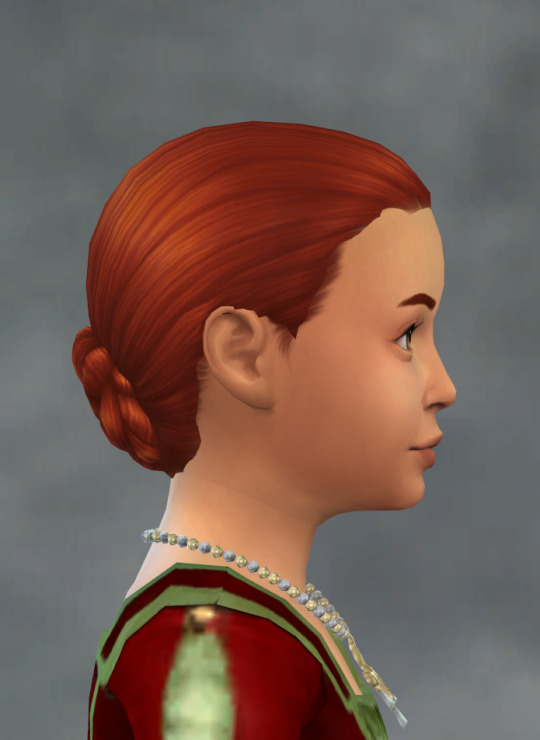
All in one merged file, unmerge if you want to edit or remerge.
Download Katharine Updo for all ages (Curseforge)
98 notes
·
View notes
Text
More Designs!
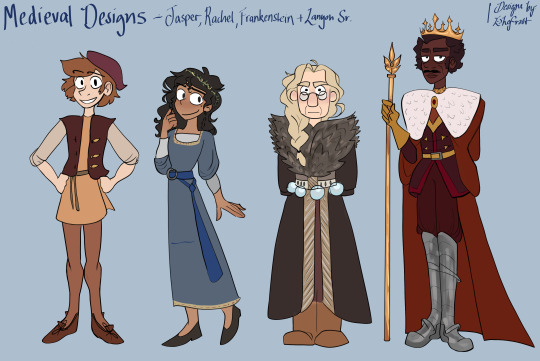
Jasper - Ok, I know he looks weird - he's just a happy boi! pls don't look too closely at the hands. So, I gave him big (and really badly drawn) calves becasue he's basically always doing some sort of exercise/work and Sage once said that he's the strongest, and we never really see his legs so I felt like showcasing those details here. Now his shoes, yet another thing that might look random, however I assure you, that these are what medieval workers use to wear. I kept his design relatively similar to his canon one, although I did have to give him a different hat.
Rachel - out of all the designs, Rachel's is the most historically accurate. it's a common misconception that women were shunned for showing their forearms/ankles but it was actually quite normal! married medieval women would wear veils and other elaborate headwear, however women who were not would either wear their hair loose or in a braid. Rachel isn't married so she wears it loose, I added a little braid that she puts flowers and decorative items in, to make her design a little bit more interesting. (and becasue its pretty)
Frankenstein - Frankenstein is really fun to draw! I don't exactly know why but she just is! She has this big fluffy pelt thing going on, it's made of a lot of fur and owl feathers, why owl feathers? because she reminds me of an owl, that's why. she also has big ol' snowboots because it snows in the swiss mountains and because I think it looks cute. you can't see her gloves but they are dark brown (fyi). she has these vials attached to her belt but they can also serve as an emergencey crystal ball - you know, just in case you have to conjure up some evil spirits, as one does.
Papa Lanyon - I think Papa Lanyon sounds way funnier than Lanyon sr. and it contrasts his serious face. I anticipated that he was going to be really hard to draw, but It was surprisingly easy. I liked his design until I had to colour him, I really don't know what happened there, I'm slightly annoyed because I wanted him to appear very cool and dapper, yet he really looks like a generic king. So this doesn't have to be his official design, he just wears fancy king clothes (it's not that important anyway because we don't see him all that much) he is wearing metal soldier-like boots, solely because I searched up outfit references and they all had soldier boot things.
Now that I've done this, I have no more excuses to procrastinate doing work for the other things in the au. Anyway I hope everyone likes these. have a nice day/moring/afternoon/night!
*just realised I forgot to colour their eyes, I'll add later!
#the glass scientists au#the glass scientists#tgs#tgs au#echo's au's#tgs jasper#tgs rachel#tgs frankenstein#jasper kaylock#rachel pidgley#victoria frankenstein#tgs medieval au
79 notes
·
View notes
Text
Idea: a knight’s helm that is shaped like headwear from ordinary life. In history, most knights were nobles and/or full-time warriors, but fantasy characters from other walks of life might earn enough cash for some armor and enough glory for a knighthood. For instance, a farmer’s helm might include a brim, resembling their straw hat. Or an executioner could have a blank hood with two eyes. Or what about a plague doctor or medieval beekeeper? They have some pretty iconic hats.
Other idea: what kind of cool magic enchantments could be placed on the helm and armor of a knight from some other background? Perhaps the three-pointed helmet of a former sailor would grant the ability to stand steady on a boat and climb the rigging more easily.
159 notes
·
View notes